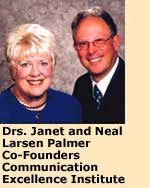
|
News Flash!
Flying Fish Communicate!
A Legend of “Customer Delight”
Vol.1, No. 5 |

|
Jan and I recently visited the world-famous Pike Place Fish Market in Seattle. For those of you for whom this doesn’t ring a bell, it’s the fish market that single-handedly changed the image and brought home the importance of world-class customer service to millions of people and thousands of organizations around the world.
It all started with boredom and self-absorption—the antithesis of customer service. The owner of a
tiny unknown fish market got so tired of his business that he’d pass the time grumbling and counting the number of steps it took him to move from counter to cooler and back again. Finally, he sold the fish market to an employee, who, with the help of a consulting firm and some great hiring practices, assembled an amazing crew of workers, who dedicated themselves to making this lowly fish market world famous for customer service.
They succeeded. Numerous books, videotapes (including the famous “Fish” videos), and seminars later, they have had a profound impact on the world of customer service training. We saw their reputation first-hand when we entered the far end of the mall where the Pike Place Fish Market is located. When we asked a flower vendor where the fish market was, she responded “You mean where they throw the fish?” (There were several other fish markets in the mall, but only one where they threw fish.)
So what’s with the Flying Fish? These pioneers of customer service decided that, if they were to become world famous, they would need to start at home and transform their workplace. They did so by adopting four distinct practices:
1. Choose Your Attitude (who else will?)
2. Play (discover the fun sides of the job)
3. Make Their Day (create “customer delight!”)
4. Be There (be in the moment)
These have formed four pillars of customer service. But they are all founded on two basic principles:
1. All customer service is TRAINED. It is never instinctive.
2. Good customer service is basically good communication.
Sure, the Fishmongers (as they call themselves) really live customer service to the public. But they also see their coworkers as their internal “customers.” In that spirit, they have trained themselves (they call it coaching) to communicate better. First, they’ve learned the power of a person’s self-talk and their absolute power to determine what that talk will sound like. How many staff members or employees have we heard say, TGIF (Thank God, it’s Friday!). It makes you wonder what they’ve been telling themselves and reinforcing all week before then.
After our visit to Pike Place, Jan and I re-committed to the principle that life is simply too short for anyone to be miserable at work. We at CEI live and breathe this philosophy; we continue to do what the fishmongers do: contribute to each other’s greatness every day.
From what we’ve observed in many dysfunctional workplaces, the best single antidote for workplace malaise is a healthy dose of good service-based communication. Managers need to confront problem situations and conflicts, get people talking, build teams, and cultivate mutual respect.
It’s true. You can’t throw fish around in too many places. But you can spread a lot of goodwill and workplace satisfaction around just by taking a look at how people are communicating, then doing something about it.
Yours in communication excellence!
Jan and Neal Larsen Palmer
Communication Excellence Institute
----------------------------------------------------------------------------
P.S.
Here are some more fun shots of the Palmers and the fishmongers:

Jan making friends with Bison (Ryan Dehn)
and a handy crab

Neal at the fish counter with Dicky Yokoyama

Jan with Bugge (Dan Bugge, that is)
P.P.S.
Yes, the fishmongers are still throwing fish around, but they’ve taken their philosophy to the “graduate” level. They have just published a new book in 2004 called
Catch! A Fishmonger’s Guide to Greatness. In this 150-page volume, they espouse principles of personal responsibility and communication we at CEI have long held dear. In a nutshell, they say what we say: it doesn’t matter what you meant to say that counts; it’s what the other person took away that counts!

For anyone interested in good communication, customer service, coaching, teamwork, and personal motivation, this book is definitely for you. If you’d like to order it, click
here and you’ll be taken to Amazon.com where you can conveniently order it. It’s really worth while! Amazon also features several reviews of this remarkable book.








